The iPad Air Review
by Anand Lal Shimpi on October 29, 2013 9:00 PM ESTGPU Performance
Since the iPad Air uses the same A7 silicon as the iPhone 5s, it also uses the same on-die GPU as the 5s: IMG’s PowerVR G6430. This is a 4-cluster configuration of IMG’s latest graphics hardware, running at some relatively high frequency. I already went into some detail on the G6430 in our 5s review so I won’t rehash that here, but we’re basically looking at a shift to a more efficient scalar architecture.
I still don’t have confirmations of clock speeds, but I believe we’re looking at a max GPU clock of around 450MHz. As you’ll see from the results below, there’s a small difference in performance between the iPad Air and iPhone 5s in terms of peak GPU performance - implying very similar clocks. The difference is the iPad Air should be able to sustain its max frequency longer than the iPhone 5s can.
| Mobile SoC GPU Comparison | ||||||||||||
| PowerVR SGX 554MP4 | PowerVR G6430 | PowerVR G6430 | ||||||||||
| Used In | iPad 4 | iPhone 5s | iPad Air | |||||||||
| SIMD Name | USSE2 | USC | USC | |||||||||
| # of SIMDs | 32 | 4 | 4 | |||||||||
| MADs per SIMD | 4 | 32 | 32 | |||||||||
| Total MADs | 128 | 128 | 128 | |||||||||
| GFLOPS @ 300MHz | 76.8 GFLOPS | 76.8 GFLOPS | 76.8 GFLOPS | |||||||||
| GFLOPS as Shipping | 68.1 GFLOPS (?) | 115.2 GFLOPS | 115.2 GFLOPS | |||||||||
Since we’re talking about an A7 here and not an X-series SoC, there’s still only a 64-bit wide memory interface. As memory bandwidth is a key enabler of GPU performance I was curious to see how GPU performance compared to the outgoing iPad 4 with its much wider memory interface. Do keep in mind that the A7 does include a large system cache on-die, which can help improve effective memory bandwidth.
GFXBench 2.7
We'll start our GPU performance analysis with a look at low level results using GFXBench/GLBenchmark 2.7. The low level tests, particularly the offscreen ones, should give us some idea as to whether or not there's any increase in GPU frequency for the iPad Air vs. iPhone 5s implementations of A7.
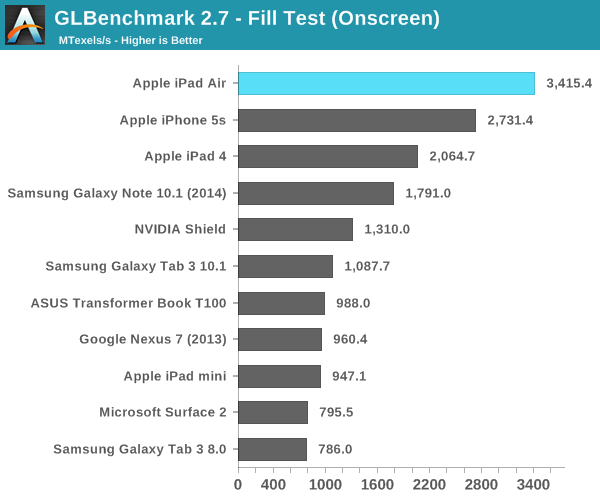
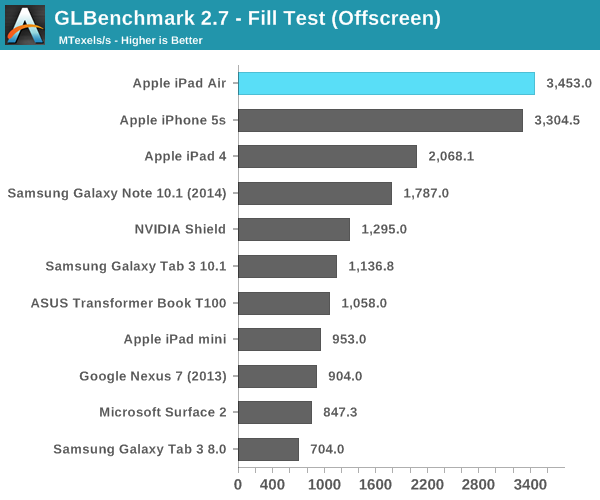
Looking at the fill rate results, there's a 4.5% increase in performance compared to the iPhone 5s. That could be the magnitude of clock increase that we're seeing between A7s. Apple could very well be relying on more thermal headroom in the iPad Air to provide any real world GPU performance advantages over the iPhone 5s.
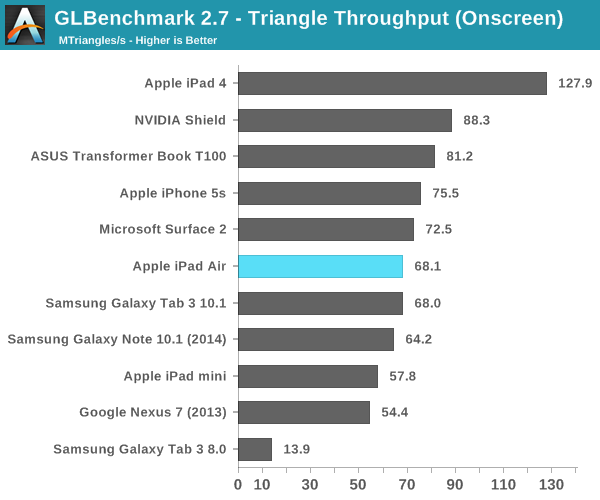

We see an even smaller gap between the Air and 5s in the triangle throughput tests (2.9%). There doesn't seem to be any substantial difference in GPU frequency between A7 implementations here. The regression in triangle rate performance compared to the iPad 4 is explained by differences in how Series 6 and Series 5XT GPUs scale in width. Whereas 5XT replicated nearly the entire GPU for "multi-core" versions, multi-cluster versions of Rogue only replicate at the shader array. The result? We don't see the same sort of peak triangle setup scaling we did back on multi-core 5XT parts. I'm not sure I'm particularly happy with the magnitude of the regression here, but I haven't seen any real world cases where it matters yet.
Next up are the game simulation tests. We'll start with the more strenuous of the two: T-Rex HD.
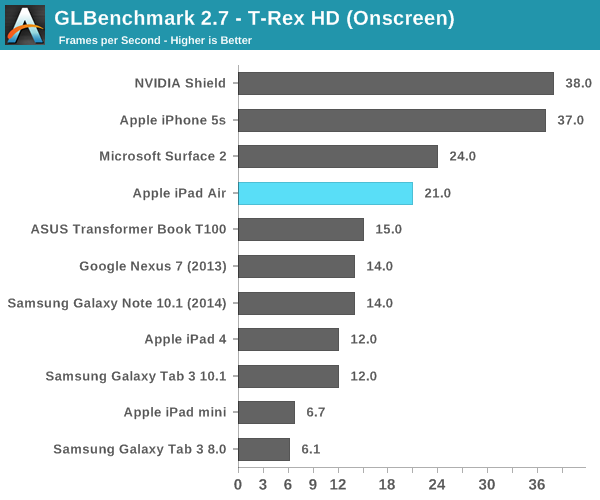
Here we get closer to Apple's claims of a 2x increase in performance. The iPad Air delivers 75% more performance than the iPad 4 in this test. Once again the iPhone 5s pulls ahead but that's because the onscreen tests render at display resolution, which is lower on the 5s.
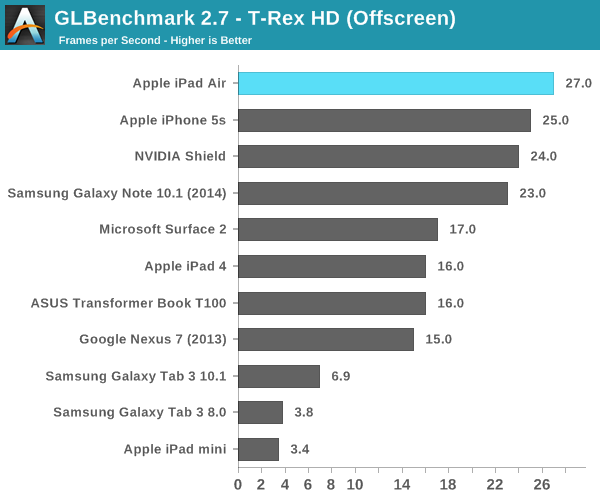
Offscreen performance sees similar scaling: ~69% better performance compared to the iPad 4.
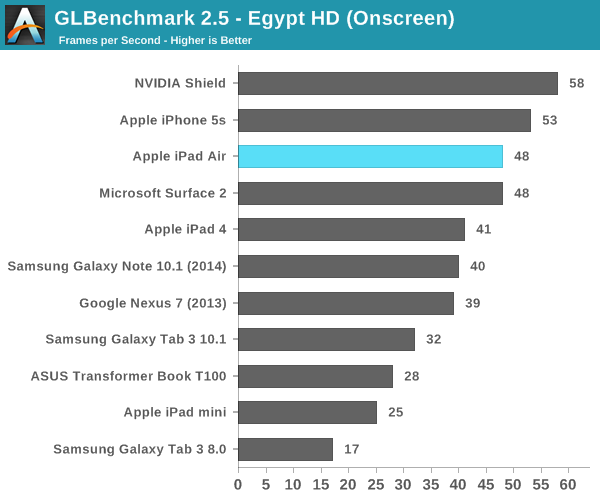
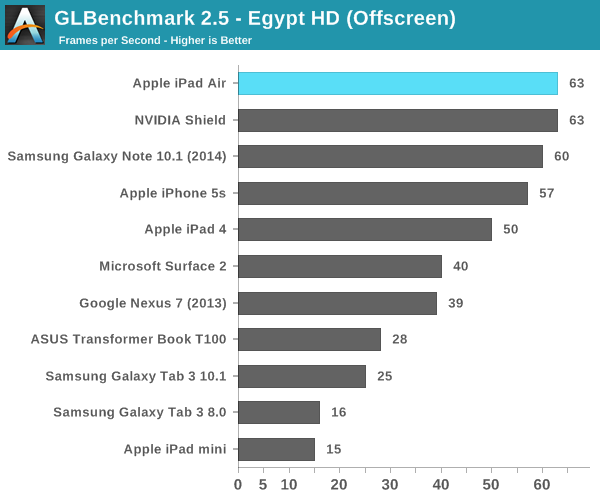
3DMark
We're once again running 3DMark's newest Unlimited mode which does its best to run independently of v-sync and at a standard resolution across all devices. I've also included 3DMark Extreme results below that feature a few more comparison points.
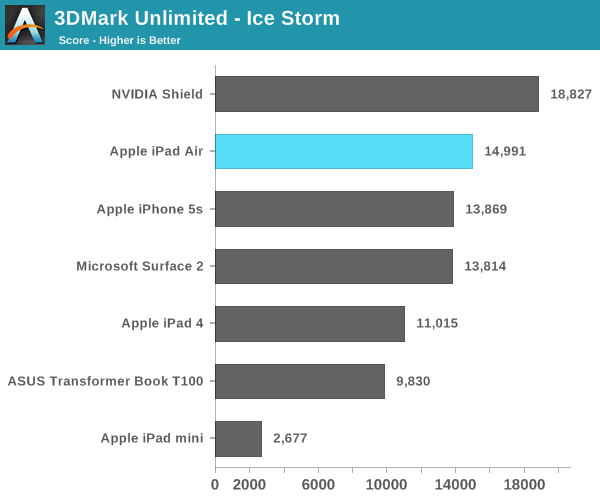
The overall Ice Storm scores show a 36% improvement in performance over the iPad 4 and an 8% increase compared to the iPhone 5s. Given the CPU frequency advantage of the A7 in the Air vs. the iPhone 5s, I'm guessing that's why we're seeing the performance gap we are here.
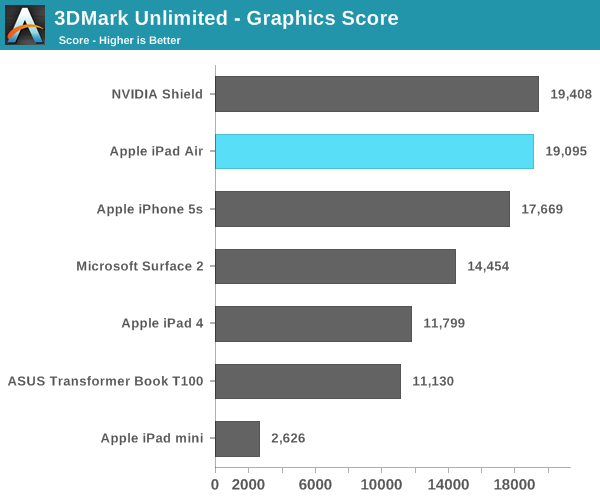
If we focus exclusively on the GPU tests (which themselves are still CPU bound), the iPad Air's performance advantage over the iPad 4 grows to over 60%.
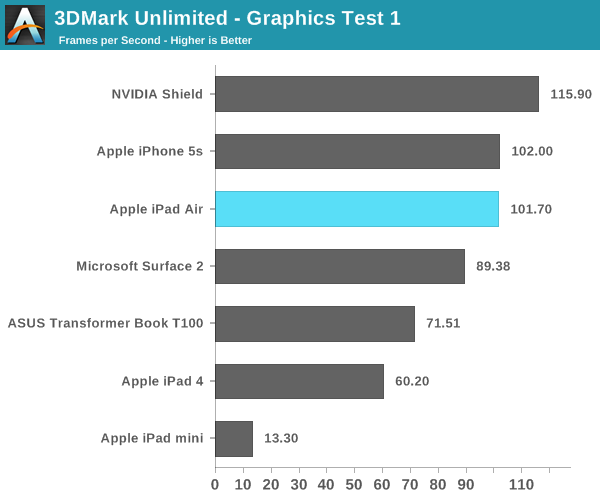
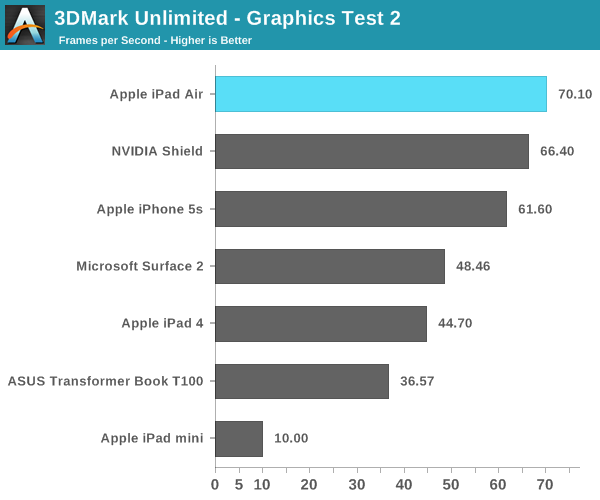
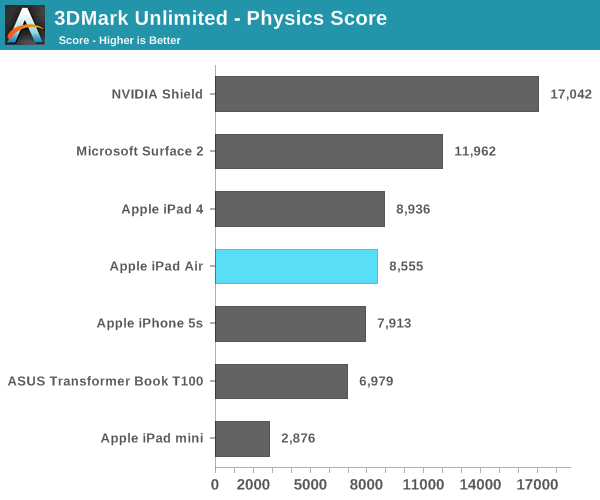
I'm still not entirely sure what's going on with the 3DMark Physics test, but we've seen this two reviews in a row now where Cyclone showed no performance increase at all compared to Swift despite this being largely a CPU test.
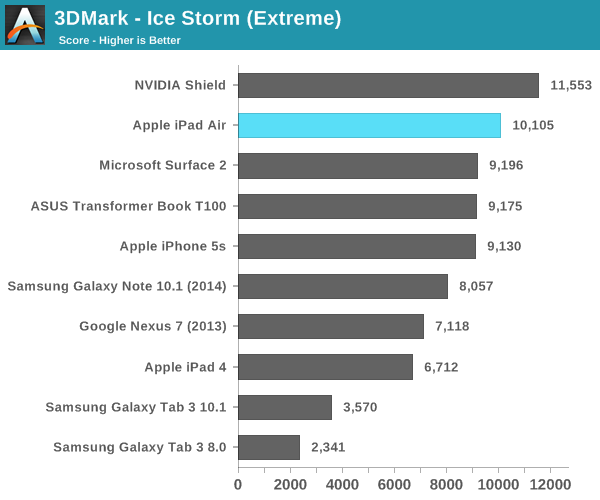
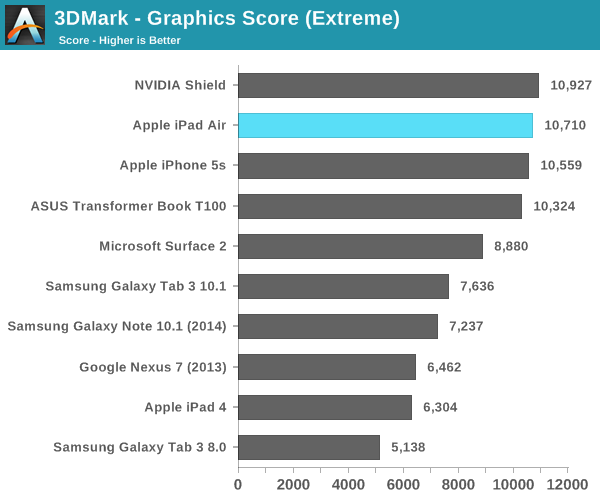
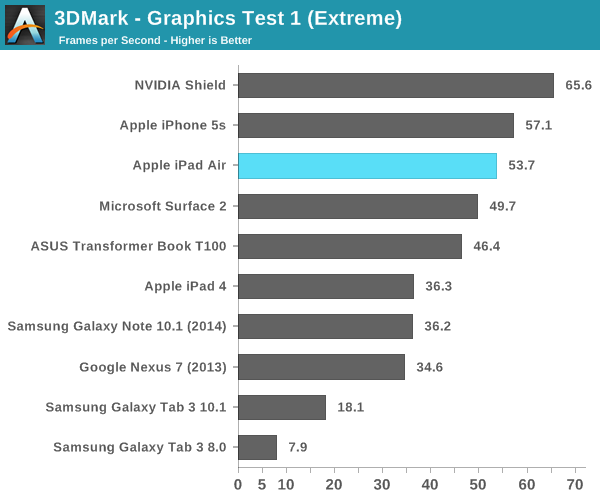
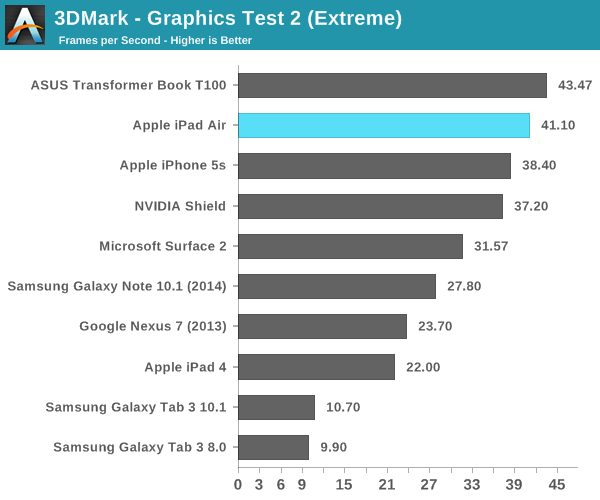

Basemark X
Basemark X is a new addition to our mobile GPU benchmark suite. There are no low level tests here, just some game simulation tests run at both onscreen (device resolution) and offscreen (1080p, no vsync) settings. The scene complexity is far closer to GLBenchmark 2.7 than the new 3DMark Ice Storm benchmark, so frame rates are pretty low.
I'm still having random issues with Basemark X reliably running both on and offscreen tests on iOS 7. Unfortunately I could only get onscreen results for the iPad Air, which came in at 46% faster than the iPad 4. Note the iPad mini and iPhone 5s benefit from having lower native resolutions here, which is why they perform so well.
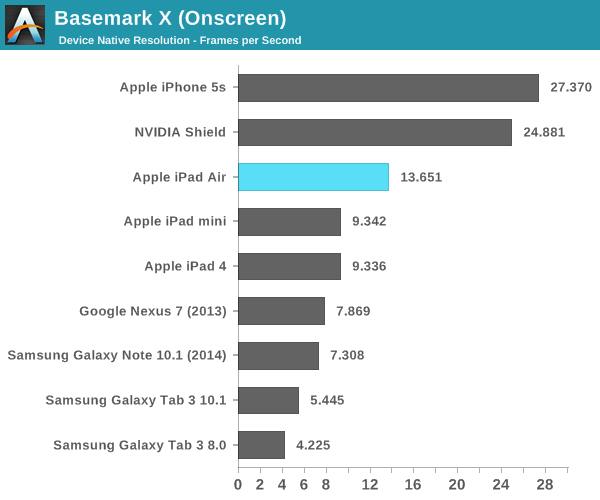










444 Comments
View All Comments
Kvaern - Wednesday, October 30, 2013 - link
You bought a first generation tech device and if you expected that to bring solid performance to the table for 5-8 years then I'm afraid it's your expectations that are the issue at hand, not the device.aliasfox - Wednesday, October 30, 2013 - link
Well, I knew I should've waited for the iPad 2, but I was taking a long trip in the fall of 2010 and it was by far the best option for internet connectivity at the time.As for 5-8 years... well, it's more that I expect $700 to last me longer. All of my other 3-4 yr old devices may be beat up, slow, and not great, but unlike the iPad 1 (on iOS5), they are still reasonably usable.
zogus - Wednesday, October 30, 2013 - link
As an owner of iPad 1 who've found the lack of iOS 6 update frustrating, I understand your sentiment completely, and I'm kind of on the fence myself regarding the new iPads.There is one major difference between the iPad 1 situation and iPad Air, however: iPad 1 was followed less than three months later by iPhone 4, which had twice as much RAM, at which point anyone remotely tech-y could see the writing on the wall. iPad Air is not likely to have that kind of upstaging for a couple of years since iPhone 5S is still brand new, and the large number of 512MB units (iPhone 4/4S, iPad 2, iPad mini) need to be taken off the market first. Apple cannot afford to bloat iOS to the point where 1GB is insufficient for a some years to come.
aliasfox - Wednesday, October 30, 2013 - link
At the time the iPad 1 came out, it had equivalent RAM to the (then top of the line) 3GS, and twice as much as the first two iPhones and first few generations if iPod Touches. Granted, between the iPad 2/3, iPhone 4/4s, and iPad mini they've sold a boatload more 512MB devices, but the difference is a matter of scale.akdj - Wednesday, October 30, 2013 - link
Yet with an A7 device (iPhone 5s/iPad Air/iPad mini w/retina) one can now run 32 tracks in Garage Band vs. 16 on the same memory 'starved' iPad 4? More memory will come...it's a non-isssue. The iPad 2 is now in the hands of 10s of thousands of pilots on commercial airlines. Their Jep Charts and approach plates...user manuals and updates to said charts and plates work just fine.Guys/Gals....this isn't Windows. This isn't Android. Apple's conservative RAM approach significantly improves battery life...and doesn't at all seem to affect actually running currently available apps that haven't been built with iOS7 in mind, much less 64bit programming! The vast majority of apps currently available are optimized to the A5 processor with 512mb of RAM. You'll be fine...I know I sure am on both my iPad 4 and iPhone 5s. If you need 10 tabs open on Safari while manipulating photos and listening to music, buy a laptop!
stacey94 - Wednesday, October 30, 2013 - link
Isn't RAM fairly cheap anyway? It's not consuming that much power either. I don't understand the logic behind skimping on it.Spunjji - Tuesday, November 5, 2013 - link
Planned obsolescence. Simple as that.nedjinski - Tuesday, October 29, 2013 - link
Kindle Fire HDX 8.9 still beats it - sorry.Fly Molo - Tuesday, October 29, 2013 - link
...That just happened.dragonsqrrl - Wednesday, October 30, 2013 - link
...yep, unfortunately